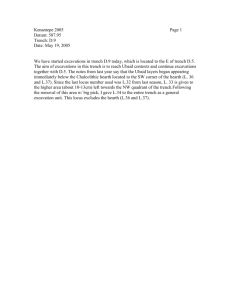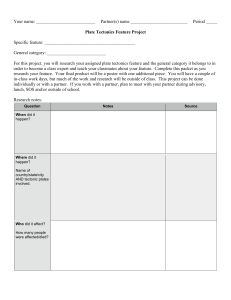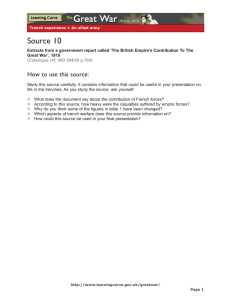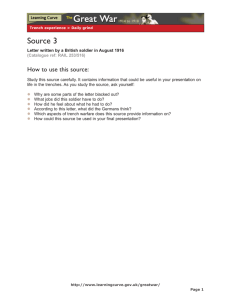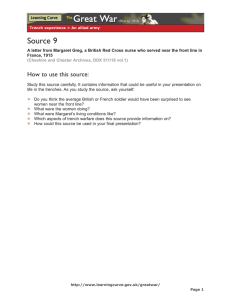TRENCH PERMIT RIDER
advertisement
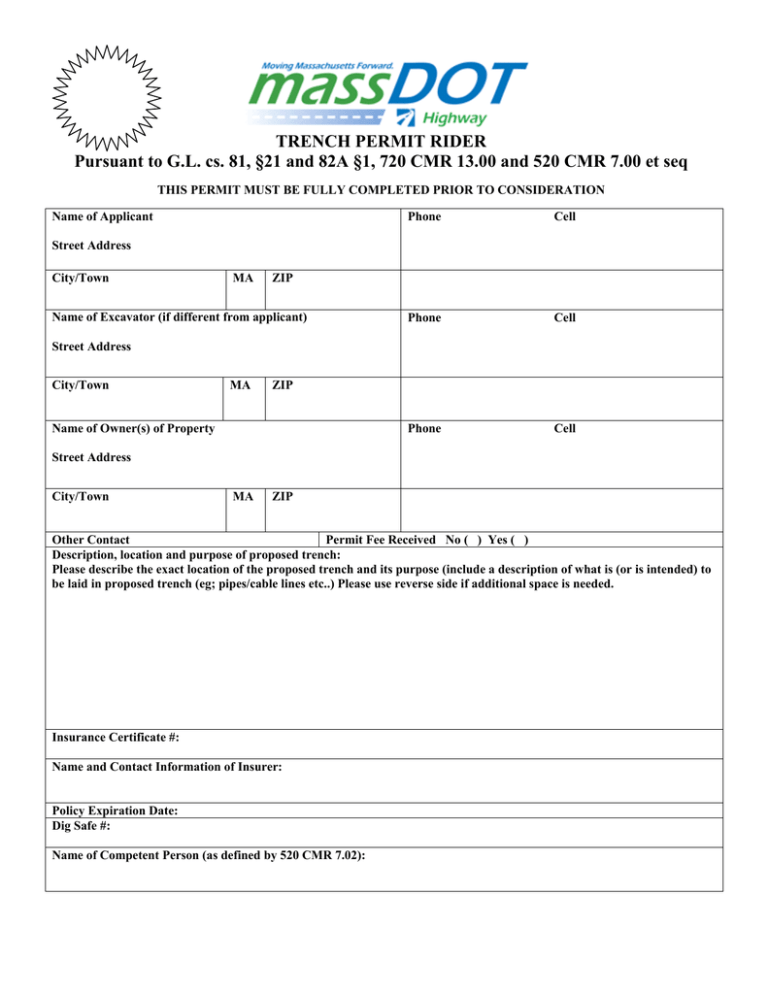
TRENCH PERMIT RIDER Pursuant to G.L. cs. 81, §21 and 82A §1, 720 CMR 13.00 and 520 CMR 7.00 et seq THIS PERMIT MUST BE FULLY COMPLETED PRIOR TO CONSIDERATION Name of Applicant Phone Cell Phone Cell Phone Cell Street Address City/Town MA ZIP Name of Excavator (if different from applicant) Street Address City/Town MA ZIP Name of Owner(s) of Property Street Address City/Town MA ZIP Other Contact Permit Fee Received No ( ) Yes ( ) Description, location and purpose of proposed trench: Please describe the exact location of the proposed trench and its purpose (include a description of what is (or is intended) to be laid in proposed trench (eg; pipes/cable lines etc..) Please use reverse side if additional space is needed. Insurance Certificate #: Name and Contact Information of Insurer: Policy Expiration Date: Dig Safe #: Name of Competent Person (as defined by 520 CMR 7.02): Massachusetts Hoisting License # License Grade: Expiration Date: BY SIGNING THIS FORM, THE APPLICANTAND EXCAVATOR ACKNOWLEDGE AND CERTIFY THAT THEY ARE FAMILIAR WITH, OR, BEFORE COMMENCEMENT OF THE WORK, WILL BECOME FAMILIAR WITH, ALL LAWS AND REGULATIONS APPLICABLE TO WORK PROPOSED, INCLUDING OSHA REGULATIONS, G.L. c. 82A, 520 CMR 7.00 et seq., AND ANY APPLICABLE MUNICIPAL ORDINANCES, BY-LAWS AND REGULATIONS AND THEY COVENANT AND AGREE THAT ALL WORK DONE UNDER THE PERMIT ISSUED FOR SUCH WORK WILL COMPLY THEREWITH IN ALL RESPECTS AND WITH THE CONDITIONS SET FORTH BELOW. THE UNDERSIGNED APPLICANT AND EXCAVATOR AGREE JOINTLY AND SEVERALLY TO REIMBURSE THE COMMONWEALTH FOR ANY AND ALL COSTS AND EXPENSES INCURRED BY THE COMMONWEALTH IN CONNECTION WITH THIS PERMIT AND THE WORK CONDUCTED THEREUNDER, INCLUDING BUT NOT LIMITED TO ENFORCING THE REQUIREMENTS OF STATE LAW AND CONDITIONS OF THIS PERMIT, INSPECTIONS MADE TO ASSURE COMPLIANCE THEREWITH, AND MEASURES TAKEN BY THE COMMONWEALTH TO PROTECT THE PUBLIC WHERE THE APPLICANT OR EXCAVATOR HAS FAILED TO COMPLY THEREWITH INCLUDING POLICE DETAILS AND OTHER REMEDIAL MEASURES DEEMED NECESSARY BY THE COMMONWEALTH. THE UNDERSIGNED APPLICANT AND EXCAVATOR AGREE JOINTLY AND SEVERALLY TO DEFEND, INDEMNIFY, AND HOLD HARMLESS THE COMMONWEALTH AND ALL OF ITS AGENTS AND EMPLOYEES FROM ANY AND ALL LIABILITY, CAUSES OR ACTION, COSTS, AND EXPENSES RESULTING FROM OR ARISING OUT OF ANY INJURY, DEATH, LOSS, OR DAMAGE TO ANY PERSON OR PROPERTY DURING THE WORK CONDUCTED UNDER THIS PERMIT. APPLICANT SIGNATURE ______________________________________ DATE _________________ EXCAVATOR SIGNATURE (IF DIFFERENT) ______________________________________ DATE _________________ PERMIT APPROVED BY PERMITTING AUTHORITY CONDITIONS OF APPROVAL For Department use -- Do not write in this section $_______ Application Fee Date CONDITIONS AND REQUIREMENTS PURSUANT TO G.L.C.82A AND 520 CMR 7.00 et seq. (as amended) By signing the application, the applicant understands and agrees to comply with the following: i. ii. iii. iv. v. vi. No trench may be excavated unless the requirements of sections 40 through 40D of chapter 82, and any accompanying regulations, have been met and this permit is invalid unless and until said requirements have been complied with by the excavator applying for the permit including, but not limited to, the establishment of a valid excavation number with the underground plant damage prevention system as said system is defined in section 76D of chapter 164 (DIG SAFE); Trenches may pose a significant health and safety hazard. Pursuant to Section 1 of Chapter 82 of the General Laws, an excavator shall not leave any open trench unattended without first making every reasonable effort to eliminate any recognized safety hazard that may exist as a result of leaving said open trench unattended. Excavators should consult regulations promulgated by the Department of Public Safety in order to familiarize themselves with the recognized safety hazards associated with excavations and open trenches and the procedures required or recommended by said department in order to make every reasonable effort to eliminate said safety hazards which may include covering, barricading or otherwise protecting open trenches from accidental entry. Persons engaging in any in any trenching operation shall familiarize themselves with the federal safety standards promulgated by the Occupational Safety and Health Administration on excavations: 29 CFR 1926.650 et.seq., entitled Subpart P “Excavations”. Excavators engaging in any trenching operation who utilize hoisting or other mechanical equipment subject to chapter 146 shall only employ individuals licensed to operate said equipment by the Department of Public Safety pursuant to said chapter and this permit must be presented to said licensed operator before any excavation is commenced; By applying for, accepting and signing this permit, the applicant hereby attests to the following: (1) that they have read and understands the regulations promulgated by the Department of Public Safety with regard to construction related excavations and trench safety; (2) that he has read and understands the federal safety standards promulgated by the Occupational Safety and Health Administration on excavations: 29 CMR 1926.650 et.seq., entitled Subpart P “Excavations” as well as any other excavation requirements established by this municipality; and (3) that he is aware of and has, with regard to the proposed trench excavation on private property or proposed excavation of a city or town public way that forms the basis of the permit application, complied with the requirements of sections 40-40D of chapter 82A. This permit shall be posted in plain view on the site of the trench. For additional information please visit the Department of Public Safety’s website at www.mass.gov/dps Summary of Excavation and Trench Safety Regulation (520 CMR 14.00 et seq.) This summary was prepared by the Massachusetts Department of Public Safety pursuant to G.L.c.82A and does not include all requirements of the 520 CMR 14.00. To view the full regulation and G.L.c.82A, go to www/mass.gov/dps Pursuant to M.G.L. c. 82, § 1, the Department of Public Safety, jointly with the Division of Occupational Safety, drafted regulations relative to trench safety. The regulation is codified in section 14.00 of title 520 of the Code of Massachusetts Regulations. The regulation requires all excavators to obtain a permit prior to the excavation of a trench made for a construction-related purpose on public or private land or rights-of-way. All municipalities must establish a local permitting authority for the purpose of issuing permits for trenches within their municipality. Trenches on land owned or controlled by a public (state) agency requires a permit to be issued by that public agency unless otherwise designated. In addition to the permitting requirements mandated by statute, the trench safety regulations require that all excavators, whether public or private, take specific precautions to protect the general public and prevent unauthorized access to unattended trenches. Accordingly, unattended trenches must be covered, barricaded or backfilled. Covers must be road plates at least ¾” thick or equivalent; barricades must be fences at least 6’ high with no openings greater than 4” between vertical supports; backfilling must be sufficient to eliminate the trench. Alternatively, excavators may choose to attend trenches at all times, for instance by hiring a police detail, security guard or other attendant who will be present during times when the trench will be unattended by the excavator. The regulations further provide that local permitting authorities, the Department of Public Safety, or the Division of Occupational Safety may order an immediate shutdown of a trench in the event of a death or serious injury; the failure to obtain a permit; or the failure to implement or effectively use adequate protections for the general public. The trench shall remain shutdown until re-inspected and authorized to re-open provided, however, that excavators shall have the right to appeal an immediate shutdown. Permitting authorities are further authorized to suspend or revoke a permit following a hearing. Excavators may also be subject to administrative fines issued by the Department of Public Safety for identified violations. Summary of 1926 CFR Subpart P -OSHA Excavation Standard This is a worker protection standard, and is designed to protect employees who are working inside a trench. This summary was prepared by the Massachusetts Division of Occupational Safety and not OSHA for informational purposes only and does not constitute an official interpretation by OSHA of their regulations, and may not include all aspects of the standard. For further information or a full copy of the standard go to www.osha.gov. • • • • • • • • • • • Trench Definition per the OSHA standard: o An excavation made below the surface of the ground, narrow in relation to its length. o In general, the depth is greater than the width, but the width of the trench is not greater than fifteen feet. Protective Systems to prevent soil wall collapse are always required in trenches deeper than 5’, and are also required in trenches less than 5’ deep when the competent person determines that a hazard exists. Protection options include: o Shoring. Shoring must be used in accordance with the OSHA Excavation standard appendices, the equipment manufacturer’s tabulated data, or designed by a registered professional engineer. o Shielding (Trench Boxes). Trench boxes must be used in accordance with the equipment manufacturer’s tabulated data, or a registered professional engineer. o Sloping or Benching. In Type C soils (what is most typically encountered) the excavation must extend horizontally 1 ½ feet for every foot of trench depth on both sides, 1 foot for Type B soils, and ¾ foot for Type A soils. o A registered professional engineer must design protective systems for all excavations greater than 20’ in depth. Ladders must be used in trenches deeper than 4’. o Ladders must be inside the trench with workers at all times, and located within 25’ of unobstructed lateral travel for every worker in the trench. o Ladders must extend 3’ above the top of the trench so workers can safely get onto and off of the ladder. Inspections of every trench worksite are required: o Prior to the start of each shift, and again when there is a change in conditions such as a rainstorm. o Inspections must be conducted by the competent person (see below). Competent Person(s) is: o Capable (i.e., trained and knowledgeable) in identifying existing and predictable hazards in the trench, and other working conditions which may pose a hazard to workers, and o Authorized by management to take necessary corrective action to eliminate the hazards. Employees must be removed from hazardous areas until the hazard has been corrected. Underground Utilities must be: o Identified prior to opening the excavation (e.g., contact Digsafe). o Located by safe and acceptable means while excavating. o Protected, supported, or removed once exposed. Spoils must be kept back a minimum of 2’ from the edge of the trench. Surface Encumbrances creating a hazard must be removed or supported to safeguard employees. Keep heavy equipment and heavy material as far back from the edge of the trench as possible. Stability of Adjacent Structures: o Where the stability of adjacent structures is endangered by creation of the trench, they must be underpinned, braced, or otherwise supported. o Sidewalks, pavements, etc. shall not be undermined unless a support system or other method of protection is provided. Protection from water accumulation hazards: o It is not allowable for employees to work in trenches with accumulated water. If water control such as pumping is used to prevent water accumulation, this must be monitored by the competent person. o If the trench interrupts natural drainage of surface water, ditches, dikes or other means must be used to prevent this water from entering the excavation. Additional Requirements: o For mobile equipment operated near the edge of the trench, a warning system such as barricades or stop logs must be o o o o o used. Employees are not permitted to work underneath loads. Operators may not remain in vehicles being loaded unless vehicles are equipped with adequate protection as per 1926.601(b)(6). Employees must wear high-visibility clothing in traffic work zones. Air monitoring must be conducted in trenches deeper than 4’ if the potential for a hazardous atmosphere exists. If a hazardous atmosphere is found to exist (e.g., O2 <19.5% or >23.5%, 20% LEL, specific chemical hazard), adequate protections shall be taken such as ventilation of the space. Walkways are required where employees must cross over the trench. Walkways with guardrails must be provided for crossing over trenches > 6’ deep. Employees must be protected from loose rock or soil through protections such as scaling or protective barricades.

